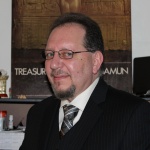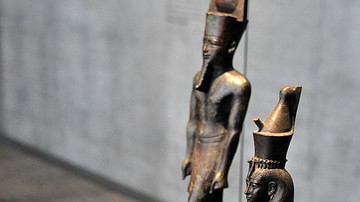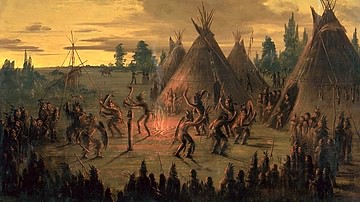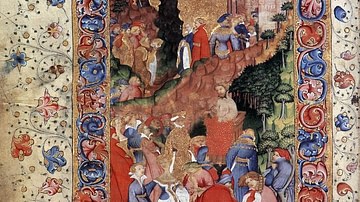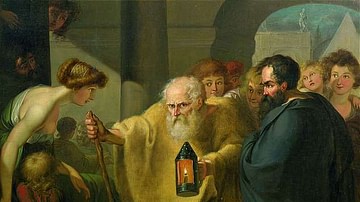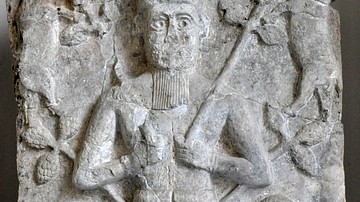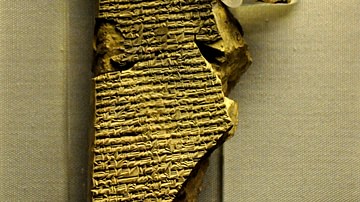De-Ka-Nah-Wi-Da and Hiawatha is the written account of the oral history of the origins of the Haudenosaunee (Iroquois) Confederacy, detailing how the great peacemaker Dekanawida (De-Ka-Nah-Wi-Da) met Chief Hiawatha and established peace between the nations. The history was written down in the late 19th century and approved by the Council of the Confederacy in 1900.
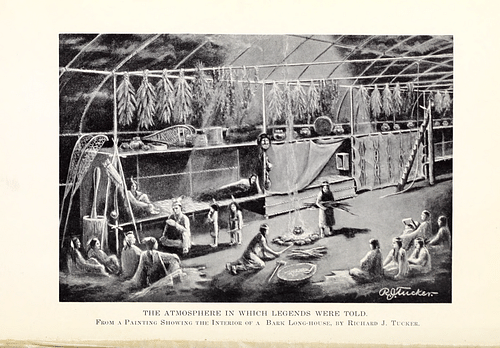
Although Dekanawida and Hiawatha are commonly cited as the ones who established the Iroquois Confederacy, there was a third, Jigonhsasee (l. c. 1142 or 15th century), who appears in the history below as "The Chief Mother" and became known as the "Mother of Nations" for the part she played. Jigonhsasee was an Iroquoian woman living near the path warriors used when going to and coming from battle. She became well-known among them for her hospitality and counsel, and so Dekanawida asked for her help in convincing the different nations to lay down their arms and unite in peace, living together in the same way a family would in a longhouse. After Dekanawida had taught Hiawatha and Jigonhsasee his precepts of peace, he left them to teach others.
The Haudenosaunee ("People of the Longhouse") Confederacy was formed in either 1142, 1390, or the 15th century (primary sources do not agree on a fixed date) and united the five nations of the Cayuga, Mohawk, Oneida, Onondaga, and Seneca. After 1715 (conditionally), and then after 1722, the Tuscarora joined as the sixth nation. These six came to be called Iroquois by French traders and explorers, though they continue to refer to themselves as Haudenosaunee. The meaning of Iroquois is still debated, but it is French in origin.
The Iroquois League, Government, & Culture
The nations that would form the Iroquois League (Haudenosaunee League, also known as "The League of Peace and Power") were constantly at war with each other until the arrival of Dekanawida and then unification through the efforts of Hiawatha and Jigonhsasee. The Iroquois League's government is the Grand Council of 50 chiefs who represent the bands (clans) that make up each nation, all of whom are Iroquoian-speaking and so united by language and culture, though the various nations have different stories, myths, and legends.
The democratic Iroquois League influenced the Founding Fathers of the United States in creating their form of government and also influenced the American Women's Suffrage Movement of the 19th century as American women noted the rights Iroquois women enjoyed. Based on the example set by Jigonhsasee, Iroquoian women had a voice in government; precisely the right American women claimed for themselves at the Seneca Falls Convention of 1848.
The Iroquois lived in longhouses sided with tree bark which could be as long as 150 feet (45 m) and 25 feet (8 m) across. As with many Native peoples of North America, the men were responsible for hunting, making war, defense of the village, making tools, and sitting on the governmental council. The Iroquois follow a matriarchal system, and so the family line passes through the women. Women raised the children, built the longhouses (sometimes with men), tended to crops, made clothing, managed trade, and sat in their own councils whose decisions influenced those of the Grand Council.
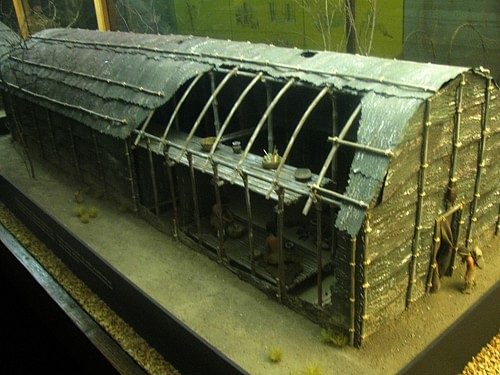
Iroquois spirituality maintains the existence of a Great Spirit, the Creator God, who is assisted by other spirits, including Thunder (who brings rainstorms), the Four Thunders (who right wrongs), and the Three Sisters, who are the spirits of corn (maize), beans, and squash. As with other Native American nations, the Iroquois see life on earth as only one plane of existence with higher realms above, which are just as real, if not more real, than this one. According to the following tale, it was the Great Spirit who sent Dekanawida to stop the bloodshed and unite the people in peace.
Text
The following text is taken from Voices of the Winds: Native American Legends by Margot Edmonds and Ella Clark, Chartwell Books, 2021. According to Edmonds and Clark:
The Hiawatha in this story is the historic person of the late fourteenth century. He should not be confused with the character in Henry Wadsworth Longfellow's poem, The Song of Hiawatha.
In the late nineteenth century, the Iroquois Six Nations Council asked their six hereditary Chiefs to write in English for the first time the traditional oral history of the formation of the League of Five Nations. It was formed about 1390, 100 years before Columbus discovered America. (The Tuscarora joined the league conditionally in 1715).
The traditional history was dictated by the six ceremonial Chiefs, one from each of these tribes: the Mohawk, Oneida, Cayuga, Seneca, Onondaga, and the Tuscarora. Two subchiefs were appointed secretaries, and the typewritten report was prepared by an Indian. On July 3, 1900, the completed history was approved by the Council of the Confederacy. (351-352)
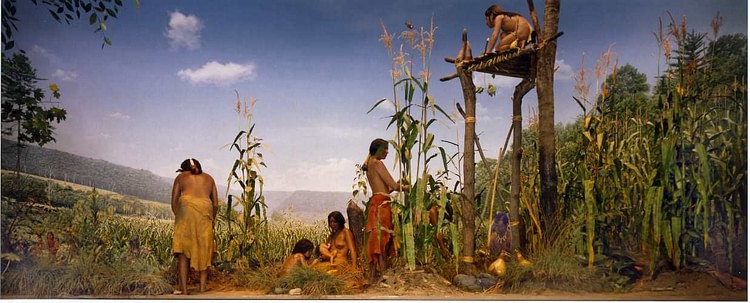
There are several versions of this legend, some including the detail of Hiawatha's daughters killed in warfare between the nations, but this is the version validated by the Grand Council in 1900:
De-Ka-Nah-Wi-Da and Hiawatha
About 1390, an Iroquois mother living near the Bay of Quinte had a very special dream: A messenger came to her and revealed that her maiden daughter, who lived at home, would soon give birth to a son. She would call him De-ka-nah-wi-da (De-kah-a-wee-da). When a grown man, he would bring to all people the good Tidings of Peace and Power from the Chief of the Sky Spirits.
De-ka-nah-wi-da was born, as the dream foretold. He grew rapidly. One day he said to his mother and grandmother, "The time has come for me to perform my duty in the world. I will now build my canoe."
When it was completed, and with the help of his mother and grandmother, he dragged the canoe to the edge of the water. The canoe was made of white stone. He got into it, waved good-bye, and paddled swiftly away to the East. A group of Seneca hunters on the far side of the bay saw the canoe coming toward them. De- ka-nah-wi-da stepped ashore and asked, "Why are you here?"
The first man replied, "We are hunting game for our living."
A second man said, "There is strife in our village."
"When you go back," De-ka-nah-wi-da told them, "You will find that peace prevails, because the good Tidings of Peace and Power have come to the people. You will find strife removed. Tell your Chief that De-ka-nah-wi-da has brought the good news. I am now going eastward."
The men on the lakeshore wondered, because the swift canoe was made of white stone. When they returned to their village and reported to their Chief, they found that peace prevailed.
After leaving his canoe on the east shore, De-ka-nah-wi-da travelled overland to another tribal settlement and asked the Chief, "Have you heard that Peace and Power have come to earth?"
"Yes, I have heard," answered the Chief. "I have been thinking about it so much that I have been unable to sleep."
De-ka-nah-wi-da then explained, "That which caused your wakefulness is now before you. Henceforth, you will be called Chief Hiawatha. You shall help me promote peace among all the tribes, so that the shedding of blood may cease among your people."
"Wait," said Hiawatha. "I will summon my people to hear you speak." All assembled quickly.
"I have brought the good tidings of Peace and Power from the Chief of the Sky Spirits to all people on earth. Bloodshed must cease in the land. The Good Spirit never intended that blood should flow between human beings."
Chief Hiawatha asked his tribe for their answer. One man asked, "What will happen to us if hostile tribes are on either side of us?"
"Those nations have already accepted the good news that I have brought them," replied De-ka-nah-wi-da. Hiawatha's tribe then also accepted the new plan of peace.
When the Messenger departed, Hiawatha walked with him for a short distance. "There is one I wish to warn you about because he may do evil to you," confided De-ka-nah-wi-da. "He is a wizard and lives high above Lake Onondaga. He causes storms to capsize boats and is a mischief-maker. I go on to the East."
Hiawatha had three daughters. The eldest became ill and died. Not long afterward, the second daughter died. All of the tribe gathered to console Hiawatha and to help him forget his great sorrow. One of the warriors suggested a game of lacrosse.
During the game, the last of Hiawatha's daughters went to the spring for water. Halfway there, she saw a beautiful high-flying bird of many bright colors. She called for the people to look at the bird. Then the huge creature swooped down toward her. In fear, she started to run back to her lodge. At the same time, the people came running to see the bird. Hiawatha's daughter was knocked down in the confusion. They did not see her, and she was trampled to death.
"Has the wizard sent that bird and caused the death of my daughter?" wondered Hiawatha. Deeper in sorrow, he decided to leave his tribe and go away.
A few days later, he met De-ka-nah-wi-da, who commissioned him a Peacemaker. Henceforth, Hiawatha would spend his time going from village to village and spread the good Tidings of Peace and Power, so that the children of the future would live in peace.
The Mohawk Nation was the first to accept the peace plan, and they invited Hiawatha to make his home with them. One night, De- ka-nah-wi-da appeared outside Hiawatha's sleeping room. "It is now urgent," he said softly, "that you come with me. We must go at once to another settlement. I have been there before, and I promised to return."
On their way, they came to a large lake. De-ka-nah-wi-da asked Hiawatha to choose between paddling across the rough water and flying over it. Remembering the warning about the wizard, he chose to fly over the lake. De-ka-nah-wi-da used his supernatural power and turned both of them into high-flying birds.
When they reached the opposite shore, they resumed their natural bodies. Then they journeyed to the top of a very high hill to see the one chief, the great wizard, who had not yet accepted the good news of peace. Upon seeing him, Hiawatha was startled–the wizard's head was a mass of writhing snakes. His hands and feet were claw-like and twisted. He used his power to persecute others.
After a long time of discussion and gentle persuasion, Hiawatha noticed that the wizard began to smile! He exclaimed, "I do want to accept your plan of Peace and Power."
At once the wizard began to change. His hands and feet straightened. Hiawatha combed the snakes from his hair. Soon other chiefs arrived to help in the wizard's regeneration.
De-ka-nah-wi-da then asked all the chiefs and their chief warriors and assistants to meet on the shores of Lake Onondaga for a Council. Hiawatha, Chief of the Mohawks, asked the Oneida, Seneca, and Cayuga chiefs to bow their heads with him before the reformed wizard, who was the Onondaga Chief Atotarho (A-ta-tar'- ho). This was their way of showing their acceptance of him and their willingness to follow his leadership when called upon.
The Messenger stood before the Council and explained a plan for the Constitution of the Iroquois League of Peace:
"Let us now give thanks to the Great Chief of the Sky Spirits, for our power is now complete. 'Yo-Hen, Yo-Hen,"' he said, meaning praise and thanksgiving.
The Great Spirit created man, the animals, earth, and all the growing things. I appoint you, Atotarho, Chief of the Onondagas, to be Fire-Keeper of your new Confederacy Council of the Five United Iroquois Nations.
"Chief Warrior and Chief Mother will now place upon your head the horns of a buck deer, a sign of your authority.
"Hiawatha shall be the Chief Spokesman for the Council. He will be the first to consider a subject and to give his opinion. He shall then ask the Seneca, Oneidas, and the Cayuga for their opinions, in that order. If not unanimous, Atotarho's opinion will be considered next. Hiawatha shall continue the debate until a unanimous decision is reached. If not accomplished within a reasonable time, the subject shall be dropped.
"Let us now make a great white Wampum of shell beads strung on deer sinews. Each bead will signify an event and create a design of memory. We shall place it on the ground before the Fire- Keeper. Beside it we shall lay a large White Wing. With it, he can wash away any dust or spot–symbolic of destroying any evil that might cause trouble.
"We shall give the Fire-Keeper a rod to remove any creeping thing that might appear to harm the White Wampum or your grandchildren. If he should ever need help, he shall call out in his thunderous voice for the other Nations of the Confederacy to come to his aid.
"Each Chief shall organize his own tribe in the same way for the peace, happiness, and contentment of all his people. Each Chief shall sit at the head of his own Council and matters shall be referred to him for final decision.
"In the future, your Annual Confederacy Council Fire shall be held here at the Onondaga village of Chief Atotarho. It will be your Seat of Government.
"Let us now plant a symbolic tree of long leaves destined to grow tall and strong. It will represent your unity and strength. When other nations wish to accept the good Tidings of Peace and Power, they shall be seated within the Confederacy Council. Atop the tall tree will proudly sit an all-seeing eagle to watch and warn you of any danger.
"Let each Chief now bring one arrow to form a bundle of arrows. Tie them together so tightly that they cannot be bent or broken apart. Place the bundle of arrows beside the Council Fire as another symbol of your unity and strength.
"Let us join hands firmly, binding ourselves together in a circle. If a tree should fall upon the circle, your circle cannot be broken. Your people can thus be assured of your unity and peace.
"If a Council Chief should ever want to remove himself as Chief, then his Horns of Authority shall be placed upon the head of his hereditary successor.
"You Chiefs must now decide what you will do with your war weapons," said De-ka-nah-wi-da.
Hiawatha then led the thoughtful discussion of the subject. The men agreed to dig a deep chasm where there was a rushing river beneath. Into this river the chiefs and their chief warriors threw all of their armaments of war. Then they closed the chasm forever.
De-ka-nah-wi-da reconvened the Council and stated:
"I charge you never to disagree seriously among yourselves. If you do, you might cause the loss of any rights of your grandchildren or reduce them to poverty and shame. Your skin must be seven hands thick to stand for what is right in your heart. Exercise great patience and goodwill toward each other in your deliberations. Never, never disgrace yourselves by becoming angry. Let the good Tidings of Peace and Power and righteousness be your guide in all your Council Fires. Cultivate good feelings of friendship, love, and honor for each other always.
"In the future, vacancies shall be filled from the same hereditary tribes and clans from which the first Chiefs were chosen. The Chief Mother will control the chiefship titles and appoint hereditary successors. New Chiefs shall be confirmed by the Confederacy Council before the Condolence Ceremony. At that time, the Horns of Authority shall be placed upon the head of the new Chief.
"All hunting grounds are to be in common. All tribes shall have co-equal rights within your common boundaries. I now proclaim the formation of the League of the Five Iroquois Nations completed. I leave in your hands these principles I have received from the Chief of the Sky Spirits. In the future you will have the power to add any necessary rules for the safety and well-being of the Confederacy.
"My mission is now fulfilled. May your Confederacy continue from generation to generation–as long as the sun will shine, the grass will grow, the water will run. I go to cover myself with bark. I will have no successor and no one shall be called by my name." De-ka-nah-wi-da departed from the Council Fire.
Chief Spokesman and Lawgiver Hiawatha arose before the Council and stated, "Hereafter, when opening and closing the Council Fire, the Fire-Keeper shall pick up the White Wampum strings and hold them high to honor all that has gone before. He will offer praise and thanksgiving to the Great Spirit. In Annual Council, the Chiefs will smoke the Pipe of Great Peace.
"If a chief stubbornly opposes matters of decision before the Council, displaying disrespect for his brother Chiefs, he shall be admonished by the Chief Mother to stop such behavior and to act in harmony. If he continues to refuse, he shall be deposed.
"If a family or clan should become extinct, the Chief's title shall be given to another chosen family within his Nation, and the hereditary title will remain within that family."
All of the Chiefs of that first Council Fire agreed with Hiawatha's plan as a part of their new Constitution.
Chief Fire-Keeper Atotarho arose before the Council with his arms outstretched, holding the White Wampum strings high in praise and thanksgiving to the Holder of the Heavens. Herewith, he closed the historic first Confederacy Council Fire of the Iroquois League of Five Nations. "Yo-Hen, Yo-Hen!" he solemnly concluded, "thank you."
The Five Chiefs then smoked the Pipe of Great Peace!

